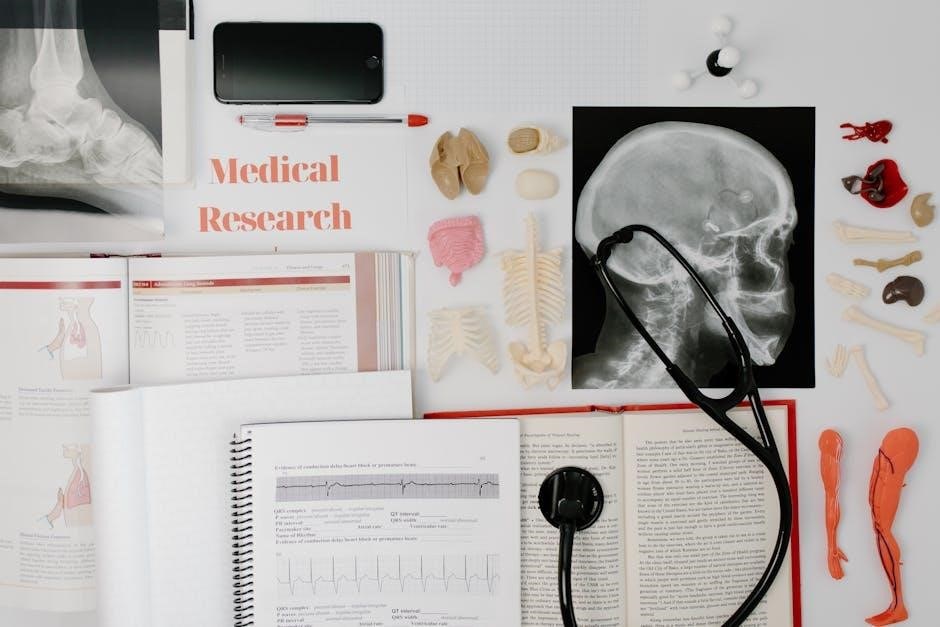Electrocardiography (ECG) is a common tool for evaluating cardiac health․ Standardized technique is crucial for accurate interpretation․ A 12-Lead ECG uses 10 wires to create 6 limb leads and 6 precordial leads․ Proper placement is vital for diagnosing cardiac dysrhythmias․

Importance of Accurate Electrode Placement
Accurate electrode placement in 12-lead ECG is paramount for reliable cardiac assessment․ Incorrect placement can lead to misinterpretations‚ potentially impacting patient care․ Precise positioning ensures accurate measurements‚ especially when comparing ECGs over time․ Even slight variations can significantly alter the ECG waveform morphology‚ mimicking or masking underlying cardiac conditions․
Proper electrode location is critical when comparing a current ECG to previous recordings‚ aiding in identifying subtle changes indicative of disease progression or treatment response․ Inaccurate placement can create artifacts‚ obscuring the true cardiac electrical activity and hindering accurate diagnosis․ Consistency in electrode placement is essential for serial ECG monitoring‚ allowing clinicians to track changes effectively․
To avoid errors‚ clinicians should adhere to established guidelines and anatomical landmarks․ Meticulous skin preparation enhances electrode adhesion and signal quality․ Regular training and competency assessments can improve placement accuracy․ Accurate ECG recordings are fundamental for making informed clinical decisions and optimizing patient outcomes․

Limb Lead Placement
For standard ECG‚ limb leads are placed on the arms and legs․ Accurate placement on the limbs‚ not the torso‚ ensures proper measurements․ Limb leads can also be placed on the upper arms and thighs for convenience or necessity․
Placement on Limbs vs․ Torso
For accurate 12-lead ECG measurements and proper interpretation‚ it is paramount that limb electrodes are consistently placed on the limbs themselves‚ rather than on the torso․ This specific placement is crucial because the criteria used for interpreting ECG results were originally developed and validated based on limb lead placement․ Deviating from this standard can introduce significant errors and inconsistencies in the ECG readings‚ potentially leading to misdiagnosis or inappropriate treatment decisions․
The standard limb placement ensures that the ECG captures electrical activity from the heart from a consistent and reliable perspective․ Placing electrodes on the torso alters the electrical field being measured‚ affecting the amplitude‚ direction‚ and timing of the waveforms․ This can create artifacts or distort the true representation of the heart’s electrical activity․ While alternative placements exist‚ they should only be used when limb placement is impossible‚ and the ECG interpretation should be done cautiously․
Alternative Limb Lead Placement (Upper Arms/Thighs)
While standard ECG practice dictates placing limb leads on the wrists and ankles‚ certain circumstances necessitate alternative placement․ When amputation‚ injury‚ or other medical conditions prevent standard placement‚ upper arms and thighs become viable alternatives․ It’s crucial to understand that this modification slightly alters the ECG’s electrical perspective‚ though it maintains the overall diagnostic value when applied correctly․
When utilizing upper arms‚ position electrodes on the upper arm‚ ensuring they’re equidistant from the shoulders and elbows․ For thigh placement‚ electrodes should be placed on the upper thigh‚ again maintaining equidistance from the hip and knee․ Consistent placement between recordings is crucial for comparative analysis․ Documenting the alternative placement within the patient’s record is also essential‚ informing subsequent interpretations․ Remember‚ interpretation should account for these placement variations․
Precordial Lead Placement
Precordial leads are vital for assessing the heart’s electrical activity․ They consist of six leads placed on the chest․ Correct placement is crucial for accurate diagnosis․ Each lead has a specific location․ This ensures consistent readings for proper interpretation․
V1 and V2 Placement
The correct placement of V1 and V2 is foundational for an accurate 12-lead ECG․ V1 is positioned in the fourth intercostal space‚ precisely along the right sternal border․ V2 mirrors V1‚ placed in the fourth intercostal space but along the left sternal border․ These locations are critical because they provide a baseline for assessing electrical activity originating from the atria and the interventricular septum․
Accurate identification of the fourth intercostal space is essential․ Palpating the angle of Louis‚ where the manubrium joins the body of the sternum‚ helps locate the second rib․ From there‚ counting down two intercostal spaces leads to the fourth․ Ensuring that V1 and V2 are directly opposite each other on either side of the sternum minimizes variability and ensures reliable ECG readings․
Any deviation from these precise locations can introduce artifacts and distort the ECG waveform‚ potentially leading to misinterpretations․ Therefore‚ careful attention to detail during V1 and V2 placement is paramount for accurate cardiac assessment․ Consistent and correct placement forms the basis for subsequent precordial lead placement․
V3 Placement
Following the accurate placement of V1 and V2‚ the next crucial step is positioning V3 correctly․ Lead V3 is strategically located midway between leads V2 and V4․ This intermediary placement is vital because V3 provides a transitional view of electrical activity as it spreads from the septum towards the left ventricle․ Its position allows for the detection of subtle changes that might be missed by V2 or V4 alone․
To ensure correct placement‚ visualize a straight line connecting the V2 and V4 electrode positions․ The V3 electrode should then be placed directly on this imaginary line‚ equidistant from both V2 and V4․ This precise positioning ensures that V3 captures the electrical activity in the transitional zone accurately․
Inaccurate V3 placement can lead to misinterpretation of the ECG‚ potentially masking or exaggerating certain waveforms․ This is especially important in cases of anterior myocardial infarction‚ where subtle ST-segment changes in V3 can be diagnostic․ Therefore‚ meticulous attention to detail is paramount when placing the V3 electrode․ Consistent and accurate V3 placement is essential for reliable ECG interpretation․
V4 Placement
After correctly placing V1‚ V2‚ and V3‚ accurate placement of V4 is crucial for capturing left ventricular activity․ V4 is located at the fifth intercostal space along the midclavicular line․ To find this location‚ first identify the fifth intercostal space by palpating down from the sternal angle (Angle of Louis)․ Then‚ locate the midclavicular line‚ an imaginary vertical line extending down from the midpoint of the clavicle (collarbone)․ The intersection of these two points marks the ideal position for the V4 electrode․
Proper placement of V4 is essential for accurate diagnosis‚ particularly in cases of myocardial infarction․ It provides a direct view of the left ventricle‚ enabling the detection of ST-segment elevation or depression‚ which are key indicators of ischemia or injury․ Incorrect placement can lead to misinterpretation‚ potentially delaying appropriate treatment․
For female patients‚ it may be necessary to displace the electrode slightly to ensure proper contact with the skin․ Always ensure the patient is relaxed and breathing normally to minimize movement artifacts․ Precise V4 placement is a cornerstone of accurate ECG interpretation․
V5 and V6 Placement
Following accurate placement of V1 through V4‚ the positioning of V5 and V6 completes the precordial lead set‚ offering a comprehensive view of the heart’s electrical activity․ V5 is placed on the anterior axillary line‚ at the same horizontal level as V4 (the fifth intercostal space)․ The anterior axillary line is an imaginary vertical line running down from the front of the armpit․ V6 is then positioned on the midaxillary line‚ also at the same horizontal level as V4 and V5․ The midaxillary line is located halfway between the anterior and posterior axillary lines․
These leads are crucial for assessing lateral wall ischemia and infarction․ Precise placement is paramount for differentiating between various cardiac conditions․ V5 and V6 provide valuable information regarding left ventricular function and can aid in the diagnosis of left ventricular hypertrophy․ Incorrect placement can mimic or mask pathological findings‚ leading to misdiagnosis․
Ensure proper skin contact by preparing the area appropriately․ Confirm that the electrodes are securely attached to minimize artifact․ Accurate V5 and V6 placement is vital for complete and reliable ECG interpretation‚ especially in detecting subtle abnormalities․

Electrode Preparation and Skin Preparation
Optimal ECG readings rely heavily on proper electrode preparation and meticulous skin preparation․ These steps ensure a clear signal transmission‚ minimizing artifacts and maximizing the accuracy of the ECG interpretation․ Before applying electrodes‚ inspect them for expiration dates and ensure the gel is moist and evenly distributed․ Dried-out electrodes compromise signal quality․ Select appropriate electrode size for the patient‚ especially for pediatric or elderly patients․
Skin preparation is equally crucial․ Begin by cleaning the electrode placement sites with an alcohol swab to remove oils‚ dirt‚ and debris․ For patients with excessive hair‚ gently shave the area to ensure direct electrode contact with the skin․ Lightly abrade the skin with a gauze pad to remove dead skin cells‚ further enhancing conductivity․ Allow the alcohol to dry completely before applying the electrodes․
Proper skin preparation reduces impedance‚ improving signal strength and minimizing interference․ Securely attach the electrodes‚ ensuring they adhere firmly to the prepared skin․ Well-prepared skin and properly functioning electrodes are fundamental for obtaining a high-quality ECG tracing‚ leading to accurate diagnosis and effective patient management․
Right-Sided ECG Electrode Placement (V4R)
A right-sided ECG involves modifying the standard 12-lead ECG to gain additional insight into right ventricular function․ The most useful lead in this configuration is V4R‚ which is obtained by transposing the V4 electrode to the right side of the chest․ Specifically‚ the V4R electrode is placed at the fifth intercostal space on the right midclavicular line‚ mirroring the standard V4 placement on the left․
This modified placement provides a direct electrical assessment of the right ventricle‚ which is particularly valuable in cases of suspected right ventricular infarction‚ pulmonary embolism‚ or congenital heart disease affecting the right side of the heart․ The V4R lead can help detect ST-segment elevation‚ indicating injury to the right ventricle․
When performing a right-sided ECG‚ it is crucial to document the modification to avoid misinterpretation of the tracing․ The remaining leads are typically placed in their standard positions․ Right-sided ECGs‚ especially with V4R‚ are essential for a comprehensive evaluation of cardiac function‚ offering specific information about the right ventricle that standard ECGs may not reveal․

Common Errors in ECG Placement and Artifacts
Inaccurate electrode placement is a significant source of artifacts in ECG recordings‚ potentially leading to misdiagnosis․ One common error involves placing limb leads on the torso instead of the limbs‚ distorting the electrical signals and affecting accurate interpretation․ Precordial lead misplacement is also frequent‚ particularly with V1 and V2 being positioned too high or too low‚ altering the P wave and QRS complex morphology․
Another error includes inconsistent intercostal space identification‚ affecting the placement of V4‚ V5‚ and V6․ Ensuring correct anatomical landmarks is crucial․ Additionally‚ inadequate skin preparation‚ such as failing to remove oils or debris‚ can result in poor electrode contact and noisy tracings․ Muscle tremors‚ patient movement‚ and electrical interference from nearby equipment contribute to artifacts as well․
Recognizing these common errors and artifacts is vital for accurate ECG interpretation․ Proper training‚ meticulous attention to anatomical landmarks‚ thorough skin preparation‚ and minimizing external interference can significantly reduce these issues․ Regularly checking electrode connections and patient comfort also helps in obtaining reliable ECG recordings․



















